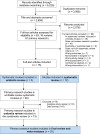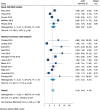E-cigarette use and combustible tobacco cigarette smoking uptake among non-smokers, including relapse in former smokers: umbrella review, systematic review and meta-analysis
- PMID: 33785493
- PMCID: PMC8011717
- DOI: 10.1136/bmjopen-2020-045603
E-cigarette use and combustible tobacco cigarette smoking uptake among non-smokers, including relapse in former smokers: umbrella review, systematic review and meta-analysis
Abstract
Objective: To review and summarise the current evidence on the uptake of combustible cigarette smoking following e-cigarette use in non-smokers-including never-smokers, people not currently smoking and past smokers-through an umbrella review, systematic review and meta-analysis.
Design: Umbrella review, systematic review and meta-analysis.
Data sources: PubMed, Scopus, Web of Science, PsychINFO (Ovid), Medline (Ovid) and Wiley Cochrane Library up to April 2020.
Results: Of 6225 results, 25 studies of non-smokers-never, not current and former smokers-with a baseline measure of e-cigarette use and an outcome measure of combustible smoking uptake were included. All 25 studies found increased risk of smoking uptake with e-cigarette exposure, although magnitude varied substantially. Using a random-effects model, comparing e-cigarette users versus non-e-cigarette users, among never-smokers at baseline the OR for smoking initiation was 3.25 (95% CI 2.61 to 4.05, I2 85.7%) and among non-smokers at baseline the OR for current smoking was 2.87 (95% CI 1.97 to 4.19, I2 90.1%). Among former smokers, smoking relapse was higher in e-cigarette users versus non-users (OR=2.40, 95% CI 1.50 to 3.83, I2 12.3%).
Conclusions: Across multiple settings, non-smokers who use e-cigarettes are consistently more likely than those avoiding e-cigarettes to initiate combustible cigarette smoking and become current smokers. The magnitude of this risk varied, with an average of around three times the odds. Former smokers using e-cigarettes have over twice the odds of relapse as non-e-cigarettes users. This study is the first to our knowledge to review and pool data on the latter topic.
Prospero registration number: CRD42020168596.
Keywords: epidemiology; public health; respiratory medicine (see thoracic medicine).
© Author(s) (or their employer(s)) 2021. Re-use permitted under CC BY-NC. No commercial re-use. See rights and permissions. Published by BMJ.
Conflict of interest statement
Competing interests: None declared.
Figures




References
-
- World Health Organization . Tobacco, 2019. Available: https://www.who.int/health-topics/tobacco [Accessed 31 Oct 2019].
-
- Guerin NW, ASSAD V. Statistics & trends: australian secondary students’ use of tobacco, alcohol, over-the-counter drugs, and illicit substances. 2018. Melbourne: Cancer Council Victoria, 2017.
-
- Australian Institute of Health and Welfare . Australian burden of disease study: impact and causes of illness and death in Australia 2015. Canberra: AIHW, 2019.
Publication types
MeSH terms
LinkOut - more resources
Full Text Sources
Other Literature Sources
Medical
Miscellaneous
